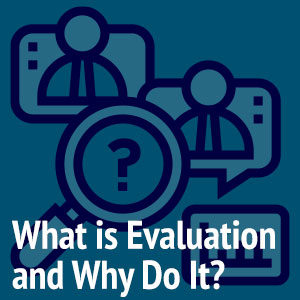 When you’re thinking about doing an evaluation — either conducting one yourself, or working with an external evaluator to conduct the evaluation — there are a number of issues to consider. (See our earlier article “Approaching an Evaluation—Ten Issues to Consider”)
When you’re thinking about doing an evaluation — either conducting one yourself, or working with an external evaluator to conduct the evaluation — there are a number of issues to consider. (See our earlier article “Approaching an Evaluation—Ten Issues to Consider”)
I’d like to briefly focus on four of those issues:
- What is the “it” that is being evaluated?
- What are the questions that you’re seeking to answer?
- What concepts are to be measured?
- What are appropriate tools and instruments to measure or indicate the desired change?
1. What is the “it” that is being evaluated?
Every evaluation needs to look at a particular and distinct program, initiative, policy, or effort. It is critical that the evaluator and the client be clear about what the ‘it” is that the evaluation will examine. Most programs or initiatives occur in a particular context, have a history, involve particular persons (e.g. staff and clients/service recipients) and are constituted by a set of specific actions and practices (e.g., trainings, educational efforts, activities, etc.) Moreover, each program or initiative has particular changes (i.e. outcomes) that it seeks to produce. Such changes can be manifold or singular. Typically, programs and initiatives seek to produce changes in attitudes, behavior, knowledge, capacities, etc. Changes can occur in individuals and/or collectivities (e.g. communities, schools, regions, populations, etc.)
2. What are the questions that you’re seeking to answer?
Evaluations like other investigative or research efforts, involve looking into one or more evaluation questions. For example, does a discreet reading intervention improve students’ reading proficiency, or does a job training program help recipients to find and retain employment? Does a middle school arts program increase students’ appreciation of art? Does a high school math program improve students’ proficiency with algebra problems?
Programs, interventions, and policies are implemented to make valued changes in the targeted group of people that these programs are designed to serve. Every evaluation should have some basic questions that it seeks to answer. By collaboratively defining key questions, the evaluator and the client will sharpen the focus the evaluation and maximize the clarity and usefulness of the evaluation findings. (See “Program Evaluation Methods and Questions: A Discussion”)
3. What concepts are to be measured?
Before launching the evaluation, it is critical to clarify the kinds of changes that are desired, and then to find the appropriate measures for these changes. Programs that seek to improve maternal health, for example, may involve adherence to recommended health screening measures, e.g., pap smears. Evaluation questions for a maternal health program, therefore might include: “Did the patient receive a pap smear in the past year? Two years? Three years?” Ultimately, the question is “Does receipt of such testing improve maternal health?” (Note that this is only one element of maternal health. Other measures might include nutrition, smoking abstinence, wellness, etc.)
4. What are appropriate tools and instruments to measure or indicate the desired change?
Once the concept (e.g. health, reading proficiency, employment, etc.) are clearly identified, then it is possible to identify the measures or indicators of the concept, and to identify appropriate tools that can measure the desired concepts. Ultimately, we want tools that are able either to quantify, or qualitatively indicate, changes in the conceptual phenomenon that programs are designed to affect. In the examples noted above, evaluations would seek to show changes in program participants’ reading proficiency (education), employment, and health.
We have more information on these topics:
“Approaching an Evaluation—Ten Issues to Consider”



